
by Bethany Augliere Thursday, September 14, 2017
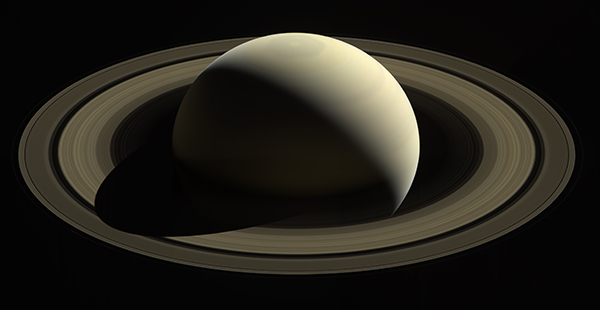
Cassini captured this view of Saturn and its rings, about 1.4 million kilometers away from the planet, using a combination of images. Credit: NASA/JPL-Caltech/Space Science Institute.
On Sept. 15, 2017, at 4:55 a.m. PT, scientists on Earth received the last transmission from the Cassini spacecraft. It descended into Saturn’s atmosphere at 122,500 kilometers per hour, which caused it to melt, thereby ensuring that Saturn’s moons Titan and Enceladus would remain protected from possible contamination by any errant Earth microbes. Cassini scientists had considered other options for the spacecraft’s end, including leaving it to float endlessly in space or parking it in orbit around Saturn. But ultimately, they chose to have it descend into Saturn’s atmosphere after deciding the data that could be returned from the descent were more valuable than any further data it might obtain by remaining in space. Scientists will make discoveries from these data for decades to come.
The last of the two frequency band signals being transmitted by Cassini was lost shortly after 4:55 a.m. PT, 30 seconds later than had been expected. “We call loss of signal at 11:55:46 for the S-band, so that would be the end of the spacecraft,” said Cassini flight director Julie L. Webster.
“You just heard the signal from the spacecraft is gone, and within the next 45 seconds so will be the spacecraft,” said Cassini project manager Earl Maize. “I hope you’re all deeply proud of this amazing accomplishment. Congratulations to you all. This has been an incredible mission, an incredible spacecraft and an incredible team. I’m going to call this the end of mission.”
After nearly 20 years in space, Cassini began its risky Grand Finale in April 2017 — a series of 22 deep dives between Saturn’s cloud tops and innermost ring before its suicidal plunge into the planet’s atmosphere. By venturing so close to Saturn, Cassini’s final orbits peeled away the layers of the atmosphere to reveal more about the interior of the planet, the gravitational and magnetic fields, and the mass of the rings. “We went to a place that no spacecraft has flown before, and I’m just looking forward to the discoveries that will come from flying through this region,” says Linda Spilker, Cassini Project Scientist at NASA’s Jet Propulsion Laboratory (JPL) at Caltech.
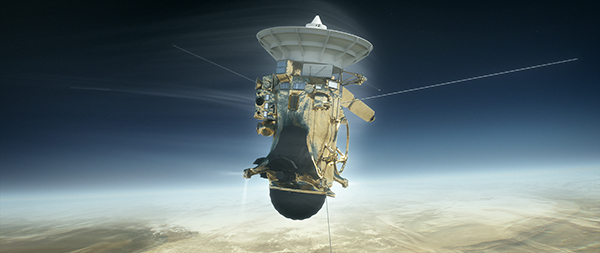
On Sept., 15, as depicted in this illustration, Cassini took its final dive into Saturn's atmosphere, just one month shy of 20 years in space. It worked to point its antenna at Earth as long as possible, until it melted in the upper atmosphere. Credit: NASA/JPL-Caltech.
The unmanned spacecraft launched on Oct. 15, 1997, as part of a joint effort by NASA, the Italian Space Agency and European Space Agency (ESA) to study Saturn, its rings and its moons, like Enceladus and Titan. Cassini first voyaged by Earth, Venus and Jupiter before finally entering orbit around Saturn on July 1, 2004. The orbiter also carried the Huygens Probe, which landed on the surface of Saturn’s largest moon, Titan, on Jan. 14, 2005. This was the first, and so far only, time that something has landed in the outer solar system. Huygens transmitted data for more than an hour on Titan’s surface, until its batteries died. After its initial four-year mission, Cassini received two seven-year extensions.
“There are a lot of miles on this particular spacecraft,” Spilker says. As Cassini ran low on fuel, scientists on the mission would have eventually lost control of it, which risked contaminating Enceladus, if it were to crash into the shiny moon whose icy oceans could harbor life. That’s why the team came up with the Grand Finale idea nearly a decade ago. “We never sterilized Cassini; we had no idea we’d have to worry about that,” Spilker says. “In some ways, Cassini is a victim of her own success. With all the discoveries on Enceladus, it’s become very clear that we want to be very careful to protect it.” (Scientists weren’t as concerned about Huygens contaminating Titan because the moon’s cold temperature and lack of liquid water likely make it inhospitable to life.)
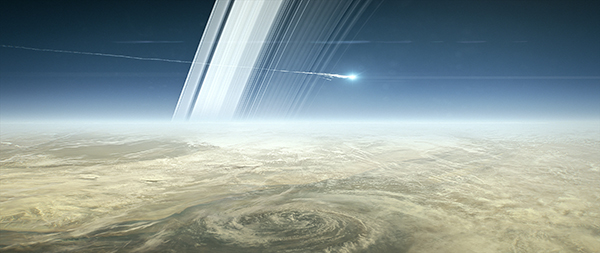
This still shot from a NASA video highlighting Cassini's accomplishments shows Cassini breaking apart and melting in Saturn's atmosphere during its Grand Finale. Credit: NASA/JPL-Caltech.
Prior to Cassini, early observations and photos of the Saturn system came from quick flybys of previous missions, including Pioneer 11 (1973), and Voyagers 1 and 2 (1977). Those missions revealed the smoggy nitrogen atmosphere of Titan, six other small moons, and the youthful age of the surface of Enceladus, which led to theories of geological activity. It became clear, however, that with Voyager’s instruments, the scientists couldn’t see through Titan’s thick upper atmosphere. That’s when three planetary scientists who are considered the fathers of Cassini — Tobias Owen, who recently passed away, Daniel Gautier and Wing Ip — pushed for a joint mission between NASA and ESA to go back to Saturn. “In one way, you can think of Cassini as standing on the shoulders of giants — the Voyagers — that came before, that laid the groundwork and that led to an orbiter at Saturn,” Spilker says.
When it launched from Earth two decades ago, the Cassini orbiter weighed 5,712 kilograms, including fuel and the Huygens Probe, and stood 6.7 meters high, 4 meters wide. Cassini was equipped with 18 instruments: 12 on the orbiter and an additional six on the probe. The various sophisticated instruments included a Cosmic Dust Analyzer to study the ice and dust grains in and around the Saturn system, a Dual Technique Magnetometer, which studied the magnetic field, and radar, which examined the mass of moons and sizes of the particles that make up the rings.
Cassini’s science mission was broken down into five broad categories: Saturn (including its weather), rings, magnetosphere, icy satellites, and Titan. “Having a spacecraft that could orbit a planet and spend a long time there gives us the opportunity to really understand the place we are visiting and then to follow up on new discoveries,” Spilker says. “It’s been really fun to be an explorer and picture myself right there looking over Cassini’s shoulder.”
By understanding weather on Saturn — governed by the same physics as Earth but under different parameters, such as proximity to the sun and atmospheric conditions — scientists can understand more about Earth’s own weather and relate weather on all the planets together, says Andrew Ingersoll, a planetary scientist based at Caltech. Seeing extreme weather on other planets helps scientists begin to understand what extremes are possible, Ingersoll says. “Weather does not just exist in separate places in isolation, and we’d like to [understand] the continuous distribution of weather phenomena in the solar system.”
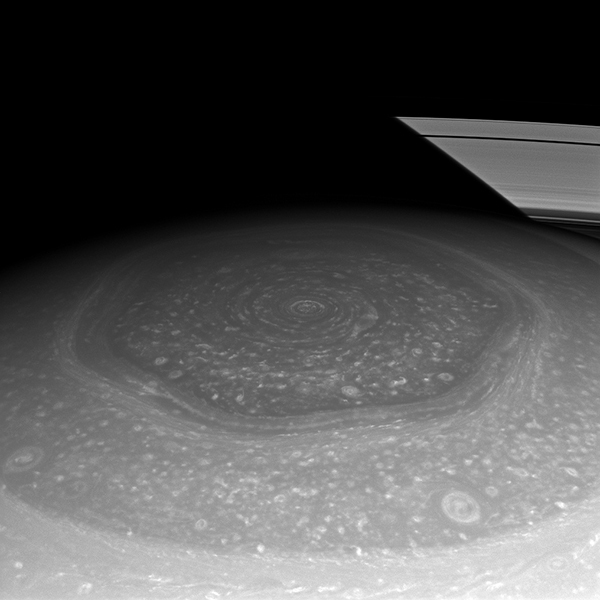
Cassini captured this image of Saturn's mysterious hexagonal jet stream lies at its north pole, lit up during spring in the northern hemisphere. Credit: NASA/JPL-Caltech/Space Science Institute.
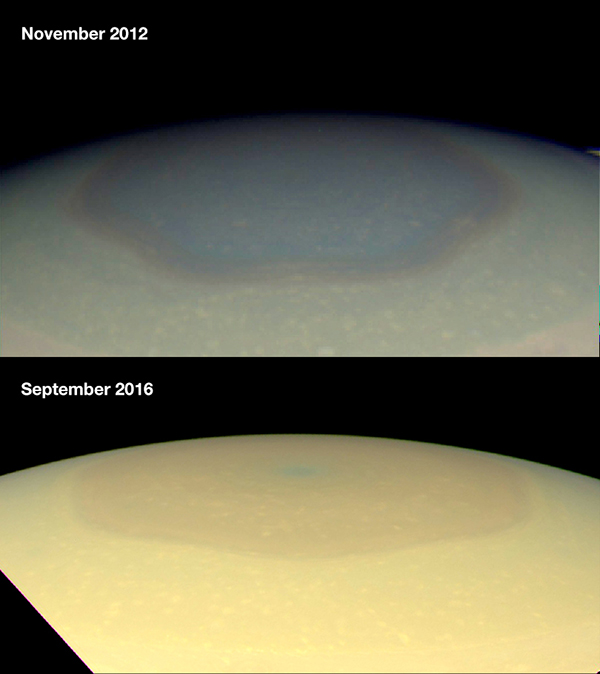
Cassini imaged the changing appearance of the hexagonal jet stream in natural color between 2012 and 2016. Scientists think the color change, from blueish to more golden, may be due to photochemical hazes in the atmosphere as the north pole approaches summer. Credit: NASA/JPL-Caltech/Space Science Institute/Hampton University.
Two weather systems scientists knew about, but which Cassini shed light on, are a hexagonal jet stream and periodic superstorms that show up every few decades. The Voyager spacecraft first captured images of Saturn’s hexagonal jet stream, which seems to be unique in the solar system, Ingersoll says. By imaging the jet stream 20 years later, Cassini revealed that it’s a long-lived weather phenomenon. Finding the jet stream was there all those years later was one of the highlights of Ingersoll’s career with the mission. “It was just a total surprise, and amazing,” he says. Earth has a jet stream too, but whereas Earth’s breaks up into eddies and re-forms every week or two, Saturn’s has only slight bends and is nearly steady over several decades.
Cassini first flew over Saturn’s north pole in 2004 and imaged the jet stream during winter. At that time, the hexagon was in shadows, so Cassini scientists used infrared imaging. As winter turned to spring, nine years later (a Saturn year is equivalent to almost 29.5 Earth years), the hexagon was better illuminated, including its interior and Cassini imaged the hexagon in the visible wavelength of light. The images revealed a symmetrical shape across a 30,000-kilometer width and winds about 500 kilometers per hour. Scientists also discovered the composition of haze particles both inside and outside the jet stream. Inside the hexagon, there’s a concentration of small haze particles, and fewer large particles, while outside the hexagon, there are large haze particles. This is similar to Earth’s own Antarctic Ozone Hole that formed within a jet stream. The concentration of the particles moving in and out of a jet stream changes with available sunlight. So, when Saturn’s summer solstice approached in 2017, the sun beamed more light onto the hexagon, and scientists could track the changes of particle composition both inside and outside the jet stream. Scientists have not yet figured out why the jet stream is six-sided, why it is there, what’s driving it, and why there isn’t one in the south as well. It’s possible that data from the Grand Finale will help answer those questions in the years to come.
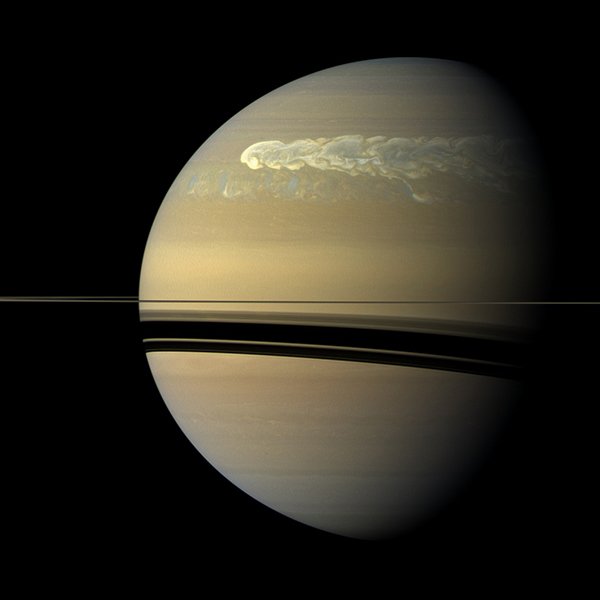
Saturn's Great White Spot storm shows up every 20 to 30 years. Cassini captured this image of the storm on Feb. 25, 2011, about 12 weeks after the storm began. Credit: NASA/JPL-Caltech/Space Science Institute.
Saturn’s other major weather system is giant thunderstorms, called “Great White Spots,” that are about the size of Earth, last several months to a year, and occur every 20 to 30 years. Unlike Earth that has more than a thousand thunderstorms at any given time, Saturn may have no thunderstorms for a year or more, and a giant thunderstorm every 20 or 30 years. One of the possible reasons Saturn doesn’t have a lot of storms is related to the amount of sunlight it receives. “That tells you something about how weather works when you turn down the amount of energy,” Ingersoll says.
Cassini managed to capture a violent storm once during its tenure in space, in 2010, which gave scientists a chance to study the storm in detail, for the year it persisted. They recorded the largest temperature increases ever recorded for a planet — 65 degrees Celsius above normal on the planet — and found molecules in the upper atmosphere never seen before, such as ethylene and acetylene. On Earth, ethylene is a naturally occurring odorless and colorless gas. It’s a hormone produced by plants and manufactured by humans during the production of plastic.
With the Grand Finale, the atmospheric scientists hope to take advantage of getting below the clouds, Ingersoll says. During its descent, Cassini sent radio signals to collect data that could show the distribution of gases, particularly ammonia, and to observe the winds, which show up as subtle irregularities in the planet’s gravity field, to discover if they have deeper roots below the cloud tops. “It’s been so much of a joyride working on Cassini, with so many discoveries. And we are going to end with plenty of questions that will luckily, keep us busy,” Ingersoll says.
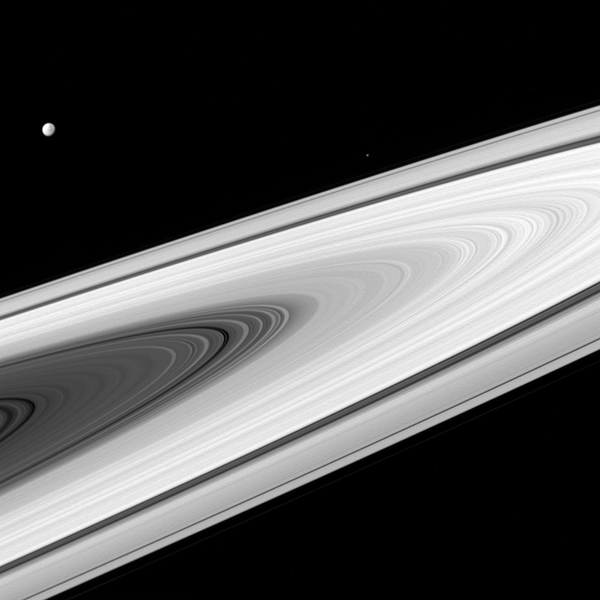
As Cassini traveled through Saturn's rings, it collected data on their temperature, size, distribution and composition. In this image, its moons Dione (left) and Epimetheus (right) can be seen. Credit: NASA/JPL-Caltech/Spacience Institute.
Saturn’s iconic rings were first discovered through a telescope in 1610 by Galileo, though he didn’t know exactly what he was looking at. Almost 400 years later, Voyager 1 and Voyager 2 advanced the world’s understanding of the rings, by discovering structure, color variation and even gaps among them. But those discoveries only fueled more questions and the desire to gain a deeper understanding. “All this amazing structure Voyager revealed — mysterious gaps, mysterious color variations — what are all these? Those were some of the reasons that we decided we needed to go back with Cassini,” says Jeffrey Cuzzi, a planetary scientist with NASA’s Ames Research Center in Moffett Field, Calif. Studying the rings can help humans understand what our solar system might have looked like before Earth and the other planets formed, he says, by revealing the rings’ structure, how particle discs behave, and how big things move around swarms of smaller things.
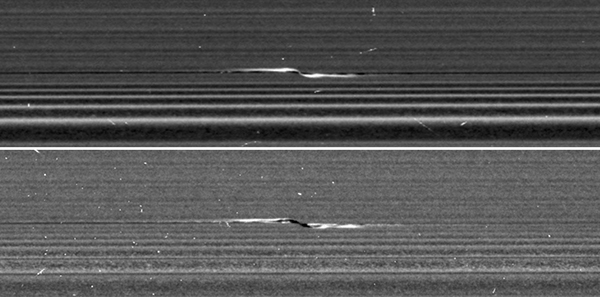
Cassini recorded strange propeller-like features in Saturn's A ring. Credit: NASA/JPL-Caltech/Space Science Institute.
It’s difficult to summarize the highlights from Cassini’s journeys through the rings, Cuzzi says, “even recapturing what we’ve learned over the last 13 years is a challenge.” To study the rings, Cassini used a combination of instruments, including radar to determine particle size, a Cosmic Dust Analyzer to determine composition and the Ultraviolet Imaging Spectrograph to observe light passing through the rings. “We have all these instruments that work together and are all complementary — it’s like we have five senses,” Cuzzi says.
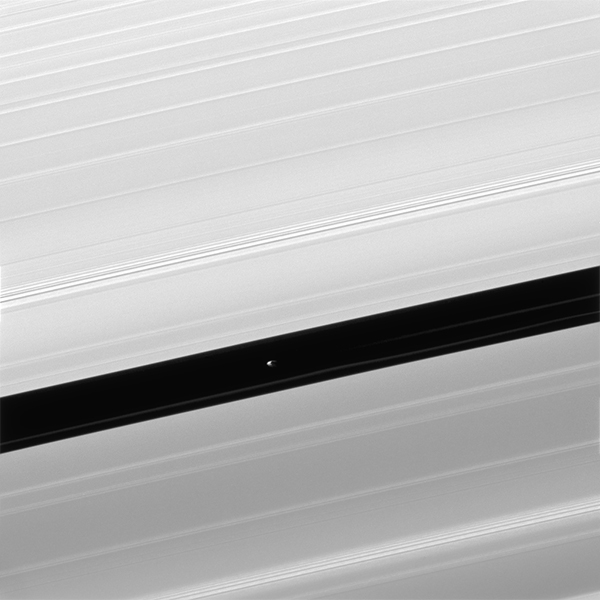
Small moons, called moonlets, maintain gaps in the rings by their gravitational influence on nearby ring particles. In this case, Pan, named for the Greek God of shepherds, maintains the Encke Gap in Saturn's A ring. Credit: NASA/JPL-Caltech/Spacience Institute.
The rings are about 282,000 kilometers across but are generally only 10 to 30 meters thick. They are made of mostly particles of water ice and rock, ranging in size from centimeters to meters. The rings vary in composition too and likely get polluted by meteoroids from beyond Saturn’s system, like from the Kuiper Belt, for instance. Larger objects the size of mountains also poke out far above some of the rings. One of Cassini’s biggest discoveries is that the rings are a dynamic and active place, and connected like a fluid rather than individual particles, Cuzzi says. “All the particles in the rings, because of their many, many collisions, have the properties of a fluid, like pressure and viscosity,” he says, so the laws of fluid dynamics apply to the rings.
Cassini also revealed details about several of the rings themselves. For instance, the material for Saturn’s E ring comes from Enceladus, which vents icy particles and gases into space. In 2006, researchers discovered propeller-like features in Saturn’s outermost dense A ring that are now known to span up to several thousand kilometers in length. These propellers are the footprint of small unseen moons, or moonlets, that disturb the ring. Then, Cassini found that the C ring is home to a rubble belt, made of perhaps silicate or carbon-rich rocky material buried withie icy particles, Cuzzi says. During the spring equinox on Saturn, long shadows over the ring particles surprised scientists, and revealed the presence of large icy bumps. Cassini found that the height of those structures is sometimes as tall as the Rocky Mountains.
One of the goals of the Grand Finale was to determine the mass of the rings and more details of their composition. The mass of the A and C ring are known, but most of the ring mass is in the B ring, which has been harder to measure. “Some people have suggested that the B ring could be 10 times as massive as we think i,” Cuzzi says. During its first ring dive, Cassini found little dust and debris. It collected what little it could with the Cosmic Dust Analyzer, which can detect particles one-thousandth of a millimeter wide. Cassini also collected the spectra of the rings to analyze composition. But “we can’t say for sure what the absolute materials are,” Cuzzi says, although in general, “we can rule out ices other than water ices.”
It’s going to be a while before all of Cassini’s data on the rings are analyzed, Cuzzi says. After all, he adds, “it took us almost 20 years to actually get to the first studies of ring color from Voyager. I think there’s going to be this long tail of growing understanding over the next couple of decades.”
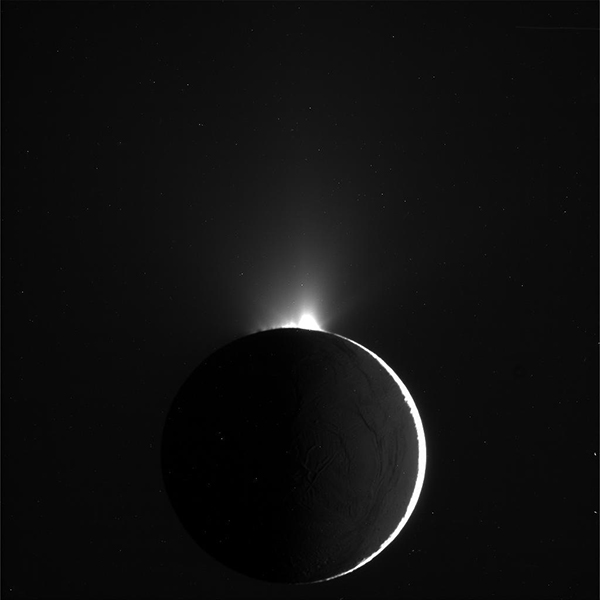
Cassini's first successful flight through the plume of Enceladus, which blasts material into space from its subsurface liquid ocean, occurred on Nov. 9, 2009. Credit: NASA/JPL/Space Science Institute.
Saturn has 62 moons, but Enceladus and Titan get most of the attention. Perhaps no discoveries by Cassini were more exciting than those about Enceladus. Enceladus is the sixth-largest moon of Saturn and about 500 kilometers in diameter. When Voyager 1 and 2 flew by, it captured images that indicated the moon was smooth and shiny. “Before Cassini, we thought Enceladus was just this small, old moon that we didn’t really understand,” says Jonathan Lunine, a planetary scientist at Cornell University. It’s the brightest object in the solar system and orbits within the E ring, but no one knew why. “There was a suspicion that it could be geologically active, but there wasn’t any evidence,” he says. Enceladus wasn’t considered a priority for the mission because compared to Titan, the tiny moon didn’t appear that interesting.
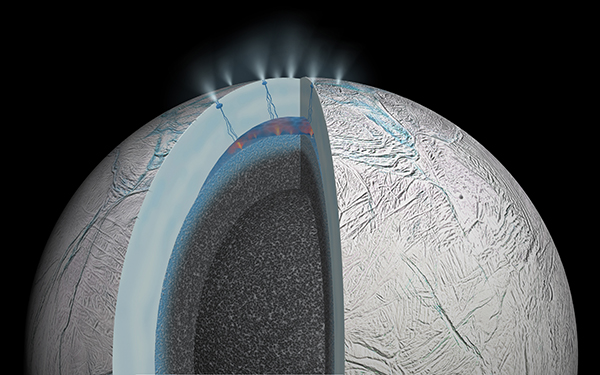
Results from Cassini suggest Enceladus may have hydrothermal activity beneath the moon's subsurface ocean, as this artist's conception shows. Geysers flow from this ocean at the moon's south pole. Credit: NASA/JPL-Caltech.
But then Cassini made a series of discoveries that suggest Enceladus has conditions that could support life. In 2005, Cassini revealed the existence of massive plumes jetting out of the moon’s south pole like a geyser into space. Those plumes, the spacecraft revealed, are composed primarily of water vapor and water ice along with some dust grains. That geyser provided evidence for a liquid ocean on the moon’s surface, Lunine says. “And that ocean we know can support life, based on the measurements that we’ve made in the plume, so [Enceladus] went from dead to a pretty fantastic world,” he says. Those larger water ice particles also carry salt — “that’s good for life,” he adds. Two different types of mass spectrometers detected organic molecules, like methane, as well as nitrogen in the plume. Then, Cassini sampled tiny silica crystals in the plume, on the scale of nanometers, which suggest that water is cycling through rock as silicon leaches out. This could serve as a food source to fuel metabolism. And most recently, Cassini revealed that molecular hydrogen is being manufactured within Enceladus, potentially by a hydrothermal reaction on the seafloor. “The best models [suggest] that rock is reacting with water to make hydrogen and silica, and that’s one way that astrobiologists think life might have had access to an energy source, early in the history of the Earth,” Lunine says.
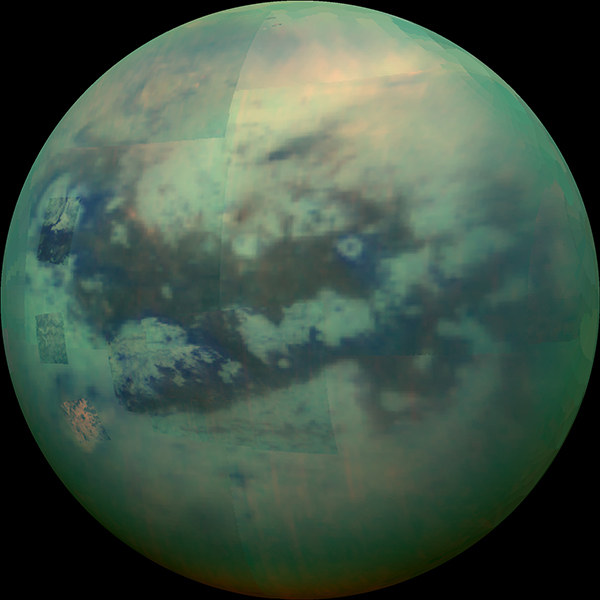
“I think it was really a spectacular series of discoveries, it’s almost a Hollywood version of a planetary mission,” Lunine says.
Other than Earth, nowhere in the solar system do you have more signs of habitability than on Enceladus, he says. And that means that we need to go back. “If there isn’t life, why not? If there is life, that’s the first alien biota to study in detail, and understand what it means to have two separate origins of life in the solar system.”
And then there’s Titan. Prior to the Cassini mission, little was known about Saturn’s largest moon, Titan, the second-largest moon in the solar system behind Jupiter’s Ganymede. Scientists knew that Titan is similarly sized to Mercury, and Voyager had revealed that the moon has a dense, nitrogen-rich atmosphere — a characteristic also found on Earth but nowhere else — with the remaining 1.6 percent composed mostly of methane and hydrogen. But the atmosphere was too thick for Voyager’s instruments to penetrate. Finding methane in the atmosphere “set up the mystery of how the methane is maintained and whether there might have been a source at the surface,” Lunine says. And that’s the reason Cassini carried a probe to Titan.
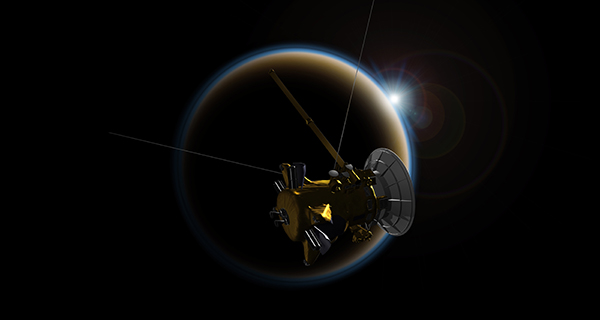
Cassini made its final flyby of Titan on Sept. 11, after which the spacecraft took off toward Saturn for its final suicidal plunge into the planet. Credit: NASA/JPL-Caltech/Space Science Institute.
While Titan has features similar to Earth, Cassini revealed that it’s an alien world, Lunine says. Cassini revealed the presence of liquid seas of methane and ethane, gullies, fractures and plains with pebbles that had been rolled until they were smooth. “It looks like a scene out of a geology textbook on fluvial erosion,” Lunine says. Cassini’s more than 120 targeted flybys near the hazy orange moon and the probe’s data have also allowed scientists to map the moon’s surface; to watch the onset of Titan winter, which adds to an understanding Titan’s seasons, the atmospheric response and how that changes habitability; and most recently, to confirm the presence of vinyl cyanide, an organic molecule.
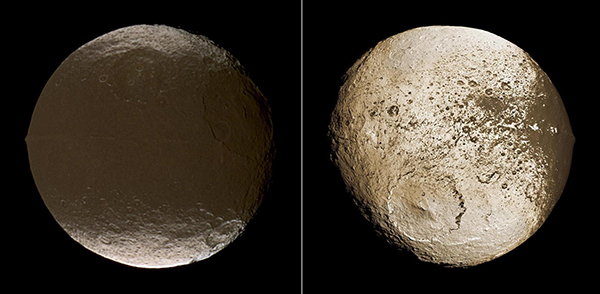
Cassini helped reveal the mysterious Yin-and-Yang coloration of Saturn's moon Iapetus. Credit: NASA/JPL/Space Science Institute.
Cassini did discover a few notable characteristics of the arguably less charismatic Saturnian moons, as well. For instance, Hyperion is characterized by an irregular shape and a chaotic rotation, likely due to a violent collision, says Bonnie Buratti, a planetary scientist at JPL. Cassini found that Hyperion also has a statically charged surface. “The only other place [we know of] where that might happen is Earth’s moon,” Buratti says.
The moon Dione intrigues scientists because Cassini’s magnetometer indicated it might be geologically active. It appears to have a couple of extinct volcanoes, but despite countless searching, no one has found proof that they are active. “It’s very frustrating that we are going to have to leave the Dione system without any proof that it might be active too,” Buratti says. Cassini also found that Dione and Rhea have very thin atmospheres, and that Iapetus’s unique coloring — “it’s half black, half white, like a black and white cookie,” Buratti says — is due to particles from Phoebe (another moon) building up on one side of Iapetus.
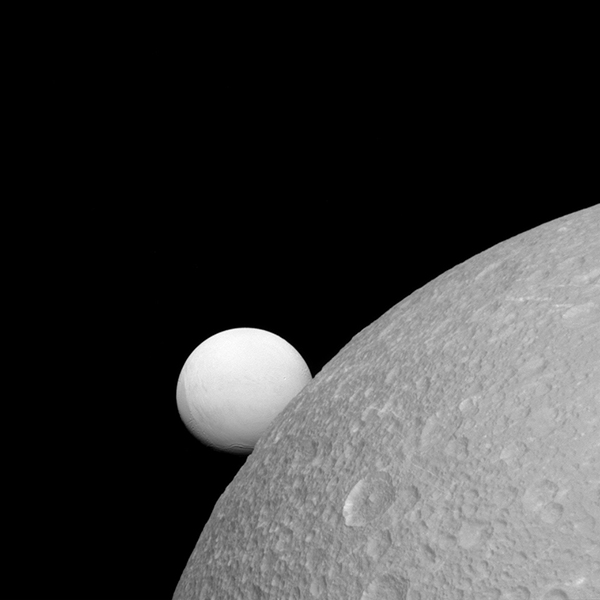
Two of Saturn's 53 moons are shown here. Dione (near) and Enceladus (far). Though the two moons are composed of mostly the same material, Enceladus has a higher reflectivity and so appears brighter. Credit: NASA/JPL-Caltech/Space Science Institute.
The reason why Iapetus displays this yin-and-yang coloration has puzzled scientists since the astronomer Giovanni Cassini first glimpsed Saturn and its moons through a telescope in 1671. But the Cassini spacecraft found the answer in 2007, and it’s a complicated story.
Iapetus is the outermost large moon of Saturn, but even farther out lies Phoebe. Phoebe rotates in the opposite direction of every other moon and because of that, likely spews its dark particles onto one face of Iapetus. The ice of Iapetus should cover that material in time — but it doesn’t. Scientists suspect that the dark material allows the ice beneath to heat up, leading to evaporation. That water vapor then finds a cold spot to condense. The bright side becomes even brighter as it collects ice, and the dark side gets darker as the proportion of dust to ice increases. “The moons are diverse; each one is different,” Buratti says. “When we first started exploring the solar system, we thought the moons would be like our own moon, just a dead cratered world, but these are unique geologic places each with their own environment.”
Similar to Earth and Jupiter, Saturn is surrounded by a magnetosphere, a region of space around the planet dominated by magnetic fields. The magnetosphere originates from the planet’s interior, composed mostly of hydrogen in a fluid metallic state around a rocky core. Saturn’s magnetosphere is the second largest in the solar system after Jupiter, though much weaker. Pioneer 11 first detected the magnetosphere during a flyby in 1979 and directly measured its strength.
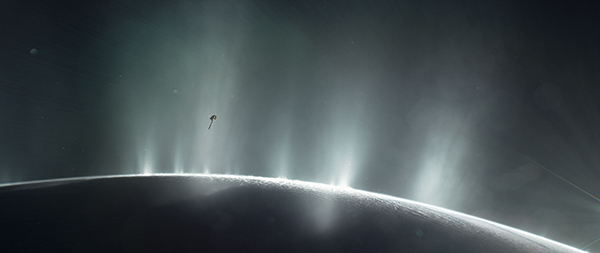
This artist's conception shows Cassini flying through Enceladus's plume. Cassini revealed that Enceladus fuels Saturn's magnetosphere. Credit: NASA/JPL-Caltech.
One of the biggest and most exciting discoveries from Cassini was finding that Enceladus fuels Saturn’s magnetosphere, says Marcia Burton, a magnetosphere and plasma science investigation scientist at JPL. Enceladus’s geyser feeds Saturn’s E ring and the plasma around Saturn. The ejecta from Enceladus’s plume is ionized and tported throughout the magnetosphere, joining the plasma surrounding Saturn, which slows its flow and therefore bends the magnetic field. Scientists found that Enceladus is the main mass-loading source to Saturn’s magnetosphere. “We didn’t think it would be that way — that the magnetosphere is really driven by Enceladus,” Burton says.
Cassini has also mapped the magnetic field, revealed the flow of excited gases under its influence, and observed how it affects Saturn’s auroras. While Cassini has answered many questions, some still remain and one in particular has scientists quite puzzled. Saturn has two magnetic poles, a north and south pole. On Jupiter and Earth, the magnetic fields are tilted with respect to the rotation axis. But on Saturn, they are nearly perfectly in line with one another. As the magnetic field lines twist and reconnect, energy is generated. Mathematical theorems suggest that a planet cannot have a self-sustaining magnetic field without because it will decay. But Saturn has an active magnetosphere and so far, no one has detected a tilt. Without a tilt, scientists also cannot determine a rotation rate for the planet.
“People are really perplexed why we can’t identify a tilt to the dipole,” Burton says. “It’s one of the biggest mysteries for planetary science.” Earth’s magnetic field protects life from harmful solar and cosmic particle radiation. “We wouldn’t be here if we didn’t have a magnetosphere, so I think its certainly an important scientific problem to address and understand fully,” she says.
Burton is hopeful that the Grand Finale will finally answer this question with a careful set of measurements by the magnetometer. To collect high-intensity magnetic field observations when the spacecraft is closest to Saturn, the scientists must roll Cassini around the magnetic field to calibrate the instrument. The team did the final set of these calibration rolls at the end of July. “The calibration rolls went great. We are still working on the data and are not quite ready to state conclusively what we have found,” Burton says. “The magnetic field measurements are one of the highest priorities of the Grand Finale.”
For many of the scientists, the end of the Cassini mission is bittersweet. Spilker, Lunine, and others have been with Cassini from the beginning and the mission has spanned their entire careers. “I feel a definite attachment to Cassini; I’ve been with the mission almost three decades,” Spilker says. “I almost see Cassini like a friend or a person. And it’s not only saying goodbye to this wonderful capable spacecraft, but saying goodbye to the Cassini family because we are all going to go our own way,” she says — except for the fact “we will be chewing on [Cassini’s] data for years to come, and that’s great, but it’s also bittersweet,” Lunine adds.
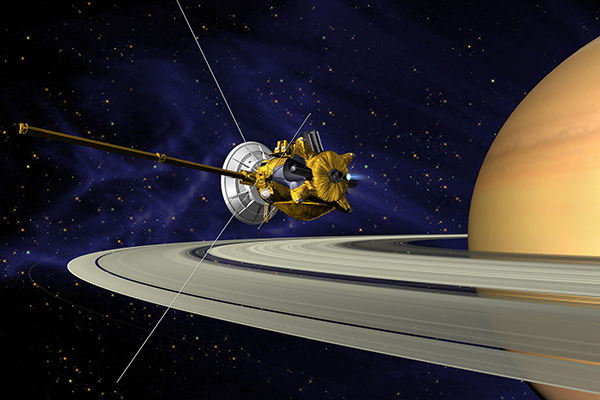
Artist's depiction of Cassini in orbit around Saturn. Credit: NASA/JPL.
One sentiment is common though, and that’s that Cassini has exceeded everyone’s expectations. Cassini was in space three times longer than originally planned. “I’m so proud of this plucky spacecraft that’s accomplished so many things and has just been a workhorse,” Spilker says.
“Cassini accomplished something that very few planetary missions have done,” Lunine says, and “that is to make a spectacular discovery and then to follow up on that discovery, and make more spectacular discoveries.”
Of all Cassini’s discoveries, those that relate to Enceladus are some of the most exciting, Lunine says. “If we discover that life actually exists on Enceladus, that is a once in a millennium discovery,” he says.
Missions are already being discussed to go back to Enceladus. In April, Spilker submitted a proposal to the NASA New Frontiers program, which is a series of missions with the purpose of reaching solar system bodies, to go to Enceladus with the kind of instrumentation that could detect amino acids and fatty acids — evidence of life. “If we could find life in our own solar system, especially that is so far from the sun, that means we don’t perhaps need a world with a liquid water ocean on the surface or in that ‘goldilocks’ zone,” Spilker says. “Are we alone? It’s such an important question.”
As of now, there are no planned missions to go back to Saturn or its moons. Yet Cassini’s discoveries have paved the way for future missions. And its legacy lives on in the discoveries yet to be made.
© 2008-2021. All rights reserved. Any copying, redistribution or retransmission of any of the contents of this service without the expressed written permission of the American Geosciences Institute is expressly prohibited. Click here for all copyright requests.